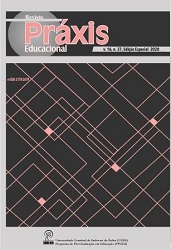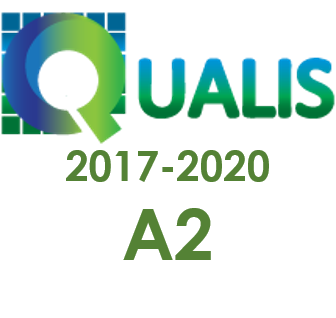IMPACT OF REGIONAL WEALTH DISPARITIES ON CHILD SCHOOLING: A CASE OF PUNJAB, PAKISTAN
DOI:
https://doi.org/10.22481/praxisedu.v16i37.6403Resumo
Este artigo tem como objetivo explorar o efeito da disparidade de riqueza entre os distritos de Punjab na matrícula escolar de crianças de 3 a 14 anos de idade no período de 2008, 2011, 2014. Este estudo utilizou o modelo probit e também usa o componente principal análise para criar um índice de disparidade de riqueza distrital para examinar como isso influencia a escolarização das crianças nas economias em desenvolvimento. As descobertas expõem que a probabilidade de matrícula escolar é influenciada negativamente pela disparidade de riqueza dos distritos nos três modelos, ou seja, para todas as crianças. Nas variáveis de controle, os domicílios que recebem remessas levam ao aumento da escolaridade das crianças. A educação dos pais aumenta a possibilidade de escolaridade nos três modelos. A educação da mãe afeta mais a matrícula infantil do que a educação da cabeça em todos os modelos. As crianças estavam menos dispostas a estudar no ano de 2007 para todos os três modelos. Os resultados sugerem que a diminuição da disparidade entre os distritos de Punjab deseja uma distribuição equivalente de fundos do governo de Punjab para os distritos. Pode aumentar o bem-estar da família através da matrícula de crianças no ensino médio. Este estudo cria um índice de disparidade de riqueza distrital usando a análise de componentes principais e utiliza uma fórmula diferencial para explicar as disparidades socioeconômicas regionais nos distritos de Punjab, no Paquistão.
Downloads
Referências
Booth, A., & Kee, H. J. (2005). The Effect of family size and birth order on educational attainment. The Australian national university center for economic policy research discussion paper birth order matters: Discussion Paper No. 506.
Borychenko, K., Hudz, A., Koval, V., Golubkova, I., & Mazur, A. (2019). European standards for social protection of internally displaced persons. Dilemas contemporaneos-educacion politica y valores, 7 (SI), 88.
Brown, P. H., & Park, A. (2002). Education and poverty in rural China. Economics of Education Review, 21(6), 523–541.
Bukanov, H., Kolesnyk, A., Tashkinova, O., Kotlubai, V., Koval, V. (2019). Social marketing in public administration of social service institutions. Revista Genero & Direito, 8 (6), 457-468.
Chabban, & Mansour. (2012). The Impact of remittances on education in Jordan, Syria and Lebanon. Working Paper No. 684.
Filmer, D., &Pritchett, L. (2001). Estimating wealth effects without expenditure data – or Tears: An application to educational enrolments in States of India. Demography, 38(1), 115-132.
Filmer, D. (2005). Gender and wealth disparities in schooling: Evidence from 44 countries. International Journal of Educational Research, 43, 351-369.
Francessa, F., Giannelli, G. C., & Grilli, L. (2013). Mothers’ employment and their children’s schooling: A Joint multilevel analysis for India. World Development, 4,183-195.
Filho, Evangelista de Carvalho, & Ferretti, Milesi M. G. (2008). Household Income as a determinant of child labor and school enrollment in Brazil: Evidence from a Social Security Reform. International Monetary Fund WP/08/241.
García, E and Demetrio. (2014). Determinants of educational outcomes: analysis of the republic of Tatarstan. Communist and Post-Communist Studies, 47, 39–47.
Huisman, J., &Smits, J. (2009). Effects of household and district-level factors on primary school enrollment in 30 Developing Countries. World Development, 37(1), 179-193.
Jamal, H. (2012). Districts’ indices of multiple deprivations for Pakistan. 2011 Research Report No. 82.
Koval, V., Polyezhayev, Y., & Bezkhlibna, A. (2018). Communicative competences in enhancing of regional competitiveness in the labour market. Baltic Journal of Economic Studies, 4(5), 105-113.
Khan, R. E. A. (2003). Children in different activities: Child schooling and child labor. The Pakistan Development Review, 42(2), 137-160.
Khan, R. E. A. (2008). Gender analysis of children’s activities in Pakistan. Pakistan Development Review, 47(2), 169-195.
Khan, U, S and Khan J. M. (2016). The impact of remittances on child education in Pakistan. The Lahore Journal of Economics, 21(1), 69–98.
Khan, R. E. A. (2010). Child labor in Pakistan: estimates and determinants. VDM Verlag Dr. Muller Aktiengesellschaft & Co. KG Germany.
Khan, U, S., & Khan J. M. (2016). The Impact of Remittances on Child Education in Pakistan. The Lahore Journal of Economics 21 (1), pp. 69–98.
Kruger, D. I., Berthelon, M., & Soares, R. (2010). Work and schooling: The role of household activities among girls in Brazil, In R. K. Q. Akee, E. V. Edmonds, & K. Tatsiramos (Eds.), child labor and the Transition between school and wor. Research in Labor Economics, 31,161–192.
Kruger, I, D. (2007). Coffee production effects on child labor and schooling in rural Brazil. Journal of Development Economics, 82, 448-463.
Popova, O., Koval, V., Antonova, L., & Orel, A. (2019). Corporate social responsibility of agricultural enterprises according to their economic status. Management Theory and Studies for Rural Business and Infrastructure Development, 41(2), 277–289.
Lincove, J, A. (2015). Improving identification of demand-side obstacles to schooling: Finding from revealed and stated preference models in two SSA Countries. World Development, 66, 69–83.
Siddiqui, A. I., & Uzma, R. (2007). Socioeconomic determinants of school progression in Pakistan. Applied Economics and International Development, 7(2), 180-196
Tharmmapornphilas, R. (2013). Impact of household factors on youth’s school decisions in Thailand. Economics of Education Review, 37, 258-272.
Tsujita, Y. (2013). Factors that prevent children from gaining access to schooling: A study of Delhi slums households. International Journal of Educational Development, 33(4), 348-357.
Downloads
Publicado
Como Citar
Edição
Seção
Licença
Você é livre para:
Compartilhar - copia e redistribui o material em qualquer meio ou formato; Adapte - remixe, transforme e construa a partir do material para qualquer propósito, mesmo comercialmente. Esta licença é aceitável para Obras Culturais Livres. O licenciante não pode revogar essas liberdades, desde que você siga os termos da licença.
Sob os seguintes termos:
Atribuição - você deve dar o crédito apropriado, fornecer um link para a licença e indicar se alguma alteração foi feita. Você pode fazer isso de qualquer maneira razoável, mas não de uma forma que sugira que você ou seu uso seja aprovado pelo licenciante.
Não há restrições adicionais - Você não pode aplicar termos legais ou medidas tecnológicas que restrinjam legalmente outros para fazer qualquer uso permitido pela licença.












